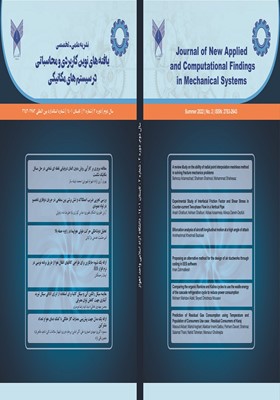تحلیل دوشاخگی حرکت طولی هواپیما در زاویه حمله بالا
محورهای موضوعی : یافته های نوین کاربردی و محاسباتی در سیستم های مکانیکی
1 - گروه مهندسی مکانیک، واحد سوسنگرد، دانشگاه آزاد اسلامی، سوسنگرد، ایران
کلید واژه: دینامیک غیرخطی, دوشاخگی, حرکت طولی,
چکیده مقاله :
تغییر زاویه حمله در پرواز باعث ایجاد تاثیر متقابل نیرو های آیرودینامیکی بال، دم و نیرو های اینرسی بریکدیگر بوده و از این رو یکی از عوامل مهم در تحلیل حرکت طولی هوانورد و ایمنی پرواز بوده است و با توجه به هزینه بر بودن آزمایشات شبیه سازی پرواز، مدل سازی حرکت هوانورد و تحلیل دینامیک غیرخطی آن از اهمیت بالایی برخوردار بوده است. در این پژوهش ضمن دستیابی به معادلات غیرخطی حرکت و مدل سازی مختلف آن، با بررسی پارامترهای دوشاخگی، تغییرات نقاط تعادل برحسب این پارامترها، تحلیل دوشاخگی هاپف، شرایط وقوع چرخه حدی، ساختارهای هتروکلینیک و مونوکلینیک مورد بررسی قرار گرفته و با استفاده از یک مدل حقیقی جنگنده، شرایط پایداری پرواز بیان شده است. این شرایط با احتساب زاویه الویتور به عنوان پارامتر دوشاخگی، پیش بینی مناسبی در تعداد نقاط تعادل برای انواع مدل، نوع نقاط تعادل، محدوده جذب، پایداری حرکت هواپیما و .. ارائه نموده است.
variation of the angle of attack in flight causes the interaction of the aerodynamic forces of the wing, the tail and the inertial forces of the brake. Hence, it has been one of the essential factors in the analysis of the plane's longitudinal movement and flight safety. And its nonlinear dynamic analysis has been of great importance. In this research, while obtaining the nonlinear equations of motion and its different modelling, by examining bifurcation parameters, the changes of equilibrium points according to these parameters, Hopf bifurcation analysis, limit cycle occurrence conditions, heteroclinic and monoclinic structures are investigated and using an actual model of aircraft, flight stability conditions are stated. These conditions, including the elevator angle as a bifurcation parameter, have provided a suitable prediction of the number of balance points for all types of models, the type of balance points, absorption range, stability of aircraft movement, etc.
[1] Nayfeh, A.H., Elzebda, J.M., Mook, D.T., (1989), Analytical study of the subsonic wing-rock phenomenon for slender delta wings, Journal of Aircraft 26(9), pp 805-809.
[2] Jahnke, C.C., Culick, F.E.C., (1994), Application of bifurcation theory to the high-angle-of-attack dynamics of the F-14, Journal of Aircraft 31(1), pp 26-34.
[3] Goman, M.G., Zagainov, J.I., Khramtsovsky, A.V., (1997), Application of bifurcation methods to nonlinear flight dynamics problems, Progress in Aerospace Sciences 33(9-10), pp 539-586.
[4] Amato, F., Cosentino, C., Merola, A., (2007), On the region of attraction of nonlinear quadratic systems, Automatica 43(12), pp 2119-2123.
[5] Seher-Weiss, S., (2011), Identification of nonlinear aerodynamic derivatives using classical and extended local model networks, Aerospace Science and Technology 15(1), pp 33-44.
[6] Zhongke, Sh., Li, F., (2013), Bifurcation analysis of polynomial models for longitudinal motion at high angle of attack, Chinese Journal of Aeronautics 26(1), pp 151-160.
[7] Qi, X., Zhongke, Sh., (2015), Bifurcation analysis and stability design for aircraft longitudinal motion with high angle of attack, Chinese Journal of Aeronautics 28(1), pp 250-259.
[8] Xi, G., Zhiwei, Sh., Keming , Ch., (2016), Experimental investigation of influence of strake wings on self-induced roll motion at high angles of attack, Chinese Journal of Aeronautics 29(6), pp 1591-1601.
[9] Ignatyev, D.I., Sidoryuk, M.E., Kolinko, K.A., Khrabrov, A.N., (2017), Dynamic rig for validation of control algorithms at high angles of attack, Journal of Aircraft 54(5), pp 1760-1771.
[10] Kou, J., Zhang, W., (2017), Multi-kernel neural networks for nonlinear unsteady aerodynamic reduced-order modeling, Aerospace Science and Technolog 64, pp 309-326.
[11] Sidoryuk, M.E., Khrabrov, A.N., Mukhanov, T.G., Grishin, I.I., (2019), Validation of Control Laws at High Angles of Attack Using Three-Degree-of-Freedom Dynamic Rig in Wind Tunnel, IFAC-PapersOnLine 52(12), pp 526-531.
[12] Norouzi, R., Kosari, A., Sabour, M.H., (2019), Real time estimation of impaired aircraft flight envelope using feedforward neural networks, Aerospace Science and Technology 90, pp 526-53434-4511.
[13] Ignatyev, D.I., Sidoryuk, M.E., Kolinko, K.A., Khrabrov, A.N., (2020), Dynamic rig for validation of control algorithms at high angles of attack, Journal of Aircraft 54(5), pp 1760-1771.
_||_
